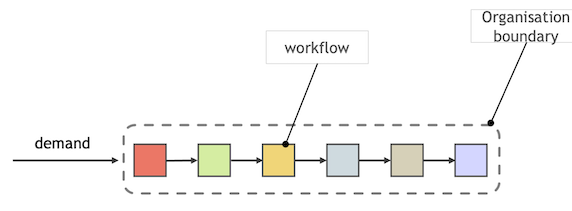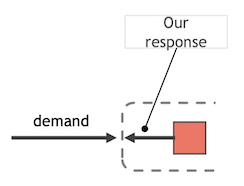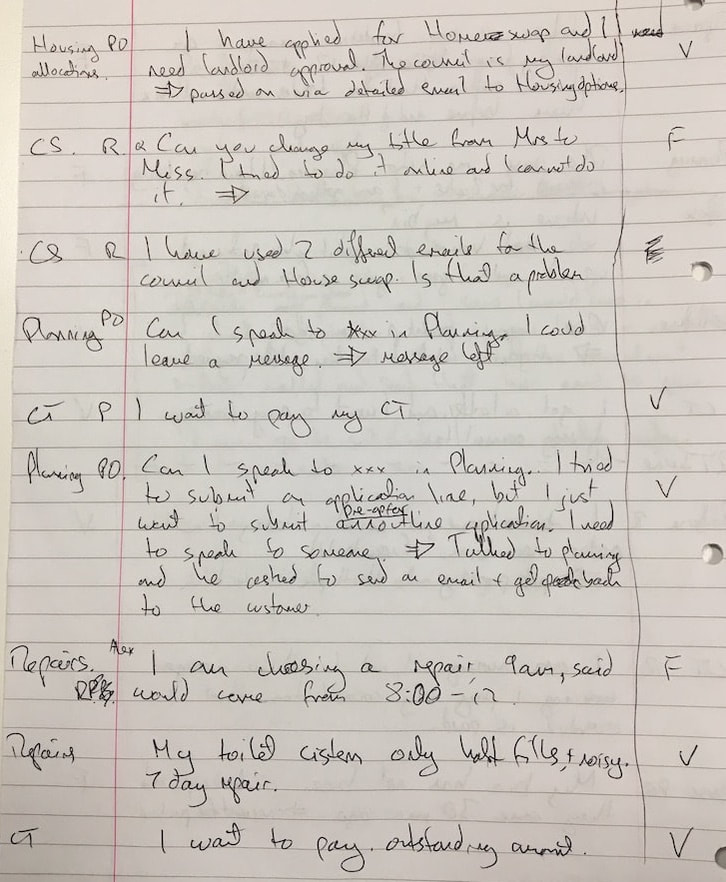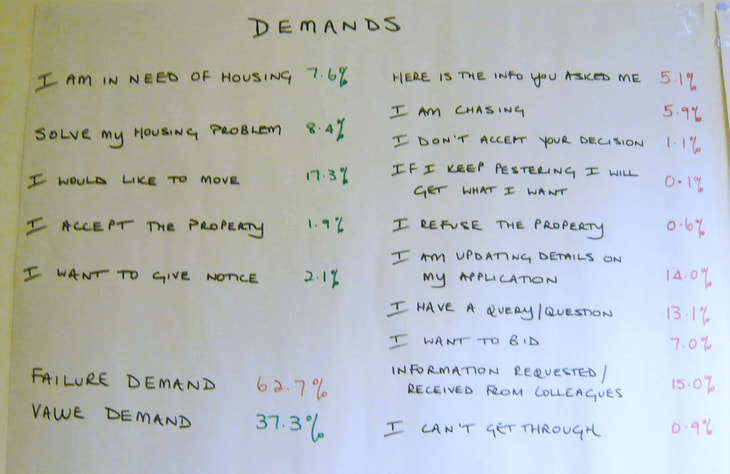How to do value & failure demand analysis
A systemic approach to understand the customer, strip out waste, and re-design a customer centred operations service
Demands into a service are the starting point of interactions with customers. Without the demand, there is no customer, and there is no service. It is the place that the customer tells us what they want and how they want it.
What do organisations typically do with those demands? Customer demands that come into services are often categorised, surveyed and polled. But very few organisations actually realise the wider potential of how Value & Failure can help them to systemically reframe the way they see the impact of their service on customers.
Demands actually form the foundation basis of their business and the value that they provide. Not only is a demand the beginning of the contact with customers, but how we interact with them informs us how well the service is designed. If we start with studying demands, using the concept of Value and Failure, it can shift what we know about the delivery of key services. It can inform a new customer centred workflow design, improving the customer interactions, and stripping out waste. It can form the basis of the Digital approach that the organisation will take.
This method is derived from John Seddon, who develop the concept of value and failure demands, and how they can be used to design services.
What do organisations typically do with those demands? Customer demands that come into services are often categorised, surveyed and polled. But very few organisations actually realise the wider potential of how Value & Failure can help them to systemically reframe the way they see the impact of their service on customers.
Demands actually form the foundation basis of their business and the value that they provide. Not only is a demand the beginning of the contact with customers, but how we interact with them informs us how well the service is designed. If we start with studying demands, using the concept of Value and Failure, it can shift what we know about the delivery of key services. It can inform a new customer centred workflow design, improving the customer interactions, and stripping out waste. It can form the basis of the Digital approach that the organisation will take.
This method is derived from John Seddon, who develop the concept of value and failure demands, and how they can be used to design services.
Purpose of demand analysis - essential for systemic design
1. To understand the demands that our service should respond to, so that we can design an optimum service.
2. Why customers are contacting us, what is important to them. So that we have good knowledge of customers.
3. In what way we should best respond to that demand, so that customers experience as seamless a journey with us as possible. This maximises satisfaction with our service.
4. That we design our services so that we minimise waste and maximise value activities. This provides us with the most cost effective way of designing the service and support services.
5. Design our operations and management structures to support this way of designing and working. So the organisation is focused and allowing for this to occur.
6. Empower employees the flexibility to make local decisions that allow for variation in demand to be absorbed. This develops employee engagement and motivates. So employees connect with the purpose of the service and therefore motivated by achievement with the customer.
2. Why customers are contacting us, what is important to them. So that we have good knowledge of customers.
3. In what way we should best respond to that demand, so that customers experience as seamless a journey with us as possible. This maximises satisfaction with our service.
4. That we design our services so that we minimise waste and maximise value activities. This provides us with the most cost effective way of designing the service and support services.
5. Design our operations and management structures to support this way of designing and working. So the organisation is focused and allowing for this to occur.
6. Empower employees the flexibility to make local decisions that allow for variation in demand to be absorbed. This develops employee engagement and motivates. So employees connect with the purpose of the service and therefore motivated by achievement with the customer.
Good questions to ask
Almost all public sector and private sector services start with demands: banks, insurance, bookings, transactional services, online sales, etc. They may be a mixture of online, calls, written and face to face.
The questions that the designer and manager may have at the point of the demand arriving is;
The questions that the designer and manager may have at the point of the demand arriving is;
- What are we doing with that demand when it arrives at our interface with our service?
- How does that interaction affect our engagement with our customer, and how much value does it provide? How well are we enabling our customers to deal with us.
- What waste is contained in this transaction, so that we can improve efficiency?
We also find that demand goes up or down over time. Increasing demands are an indication that more customers are interested in our service. The number of demands is an important measure for any organisation.
We are also interested in being efficient, so we will want to deal with demands in ways that minimise waste. What we are going to do here is to examine the nature of the demands we receive, and examine them from the point of view of the customer, value and waste.
If we examine calls demands coming in, and we ask the question;
Is every call coming in, a demand that the customer actually wants to make?
We find out that in fact, some of the calls they make are because we, the organisation, has caused those customers to call again. An example is a call where someone says; You sent me something that I do not understand. or When will I get my product?
This is not good for customer satisfaction because they are forced to call, and therefore not good for business. It is also a waste of time and resources for the service.
By focusing on customers and the value we provide, we categorise demands into two main types;
We are also interested in being efficient, so we will want to deal with demands in ways that minimise waste. What we are going to do here is to examine the nature of the demands we receive, and examine them from the point of view of the customer, value and waste.
If we examine calls demands coming in, and we ask the question;
Is every call coming in, a demand that the customer actually wants to make?
We find out that in fact, some of the calls they make are because we, the organisation, has caused those customers to call again. An example is a call where someone says; You sent me something that I do not understand. or When will I get my product?
This is not good for customer satisfaction because they are forced to call, and therefore not good for business. It is also a waste of time and resources for the service.
By focusing on customers and the value we provide, we categorise demands into two main types;
We may also find that demands have been rising, but what we have not realised is that it is often preventable or failure demand that is rising, and not the value demands that we actually want.
Therefore simply being aware of the two type of demands gives us important knowledge about our services that not only did we not know before, but we have been assuming that all demands are good. We have been making important decisions with the wrong information. Companies pride themselves on being responsive to customers, but all too often they are measuring their response to the failure demand, so they aren’t actually providing a good customer service!
To demonstrate the potential of this concept, in the organisations that I have been involved in, failure demands are between 30% - 70% of total demands! If we know this figure, then the actions we take to improve, will focus on the service flow that can then reduce those failure demands.
The important learning of this knowledge is that, if we change the way the work is designed,
we can actually eliminate these failure demands, thats why people call them preventable!
We can remove the waste that they cause, we can recover from the poor customer experience that we are inadvertently providing, and the demands coming in to the service can reduce. Looking at the figures of failure demand in any service, this improvement is often very significant.
Therefore, as a manager, designer of change consultant, what we must avoid, is designing services that have failure demand locked in.
Therefore simply being aware of the two type of demands gives us important knowledge about our services that not only did we not know before, but we have been assuming that all demands are good. We have been making important decisions with the wrong information. Companies pride themselves on being responsive to customers, but all too often they are measuring their response to the failure demand, so they aren’t actually providing a good customer service!
To demonstrate the potential of this concept, in the organisations that I have been involved in, failure demands are between 30% - 70% of total demands! If we know this figure, then the actions we take to improve, will focus on the service flow that can then reduce those failure demands.
The important learning of this knowledge is that, if we change the way the work is designed,
we can actually eliminate these failure demands, thats why people call them preventable!
We can remove the waste that they cause, we can recover from the poor customer experience that we are inadvertently providing, and the demands coming in to the service can reduce. Looking at the figures of failure demand in any service, this improvement is often very significant.
Therefore, as a manager, designer of change consultant, what we must avoid, is designing services that have failure demand locked in.









